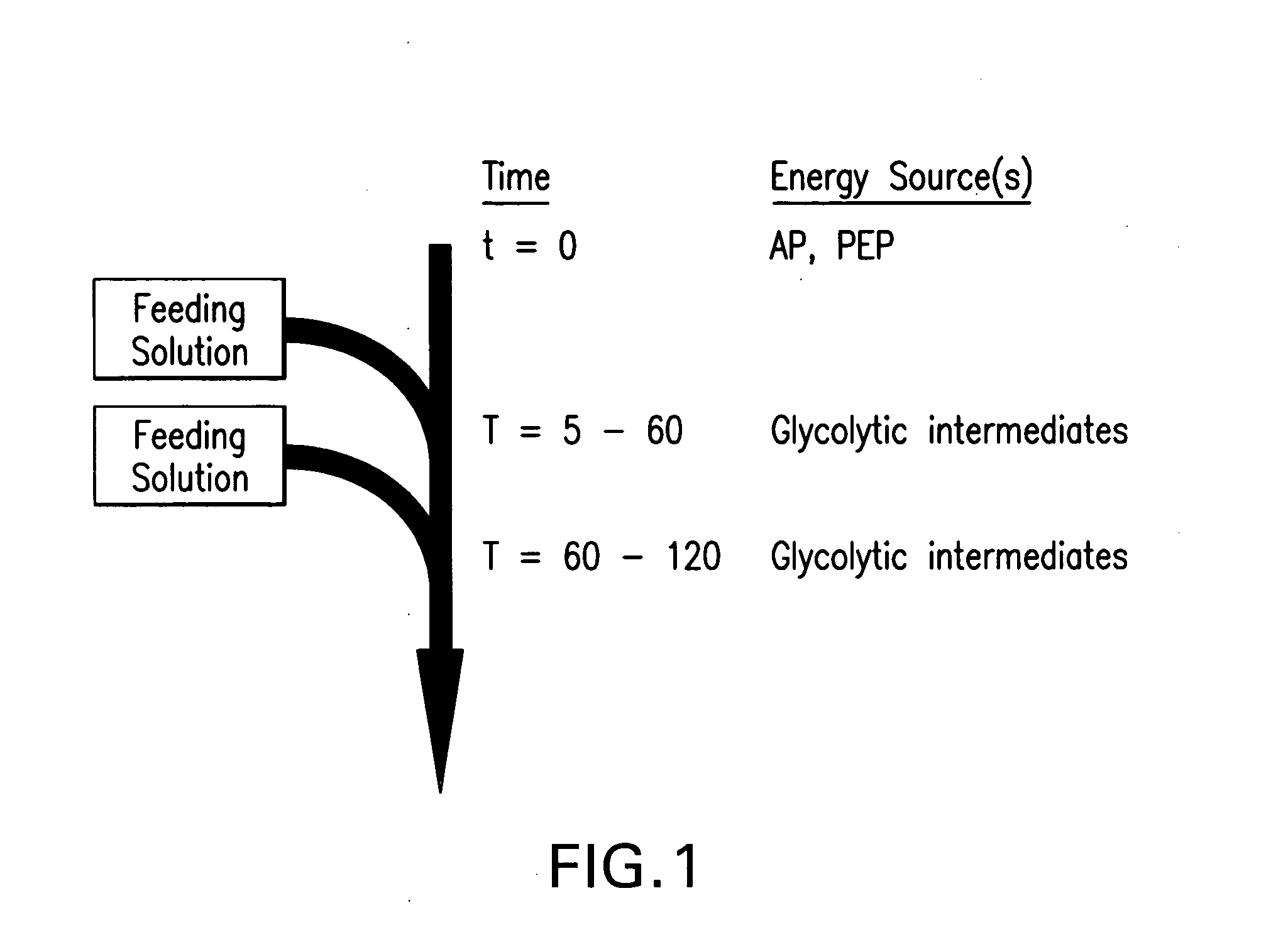Feeding buffers, systems, and methods for in vitro synthesis of biomolecules
a biomolecule and buffer technology, applied in the field of biotechnology, can solve the problems of high loss rate, difficult in vivo over-production of protein beyond a predetermined concentration, and difficult in obtaining over-production of desired protein,
- Summary
- Abstract
- Description
- Claims
- Application Information
AI Technical Summary
Benefits of technology
Problems solved by technology
Method used
Image
Examples
example 1
Compositions of Feeding Solutions
[0249] A representative Feeding Solution contains: [0250] (a) a buffer (10-100 mM final concentration); [0251] (b) one or more salts; [0252] (c) one or more reducing agents; [0253] (d) one or more energy sources and / or cofactor; [0254] (e) at least 4 amino acids; and [0255] (f) ammonium acetate
[0256] Components of a feeding solution were tested at varying concentrations in in vitro synthesis reactions to optimize protein yield from the reaction.
[0257] A. Buffers: HEPES buffer is included to maintain the pH of the reaction. The pH of the feeding solution was increased to pH 8.0 (from 7.6 in the initial reaction). HEPES buffer was included at a concentration such that the final concentration in the in vitro synthesis reaction was preferably from 20-80 mM, where an exemplary feeding solution provided a final concentration of HEPES in the reaction of 57.5 mM. Addition of buffer alone as a feed did not increase yields, but did have a slight stimulatory...
example 2
Yields and Activity with Various Components in the Feed Solution
[0265] Standard 50 microliter Expressway™ Plus (Invitrogen, Carlsbad, Calif.) reactions were assembled and incubated at 37° C. essentially according to the manufacturer's instructions. The reactions included 600-800 micrograms of E coli extract made from an RNase A minus mutant and containing 2.5 micrograms per mL of Gam protein, 820U T7 Enzyme, 20U RNase Out, 1 mM amino acids (except methionine) 1.5mM Methionine, and 0.5-1 μg template DNA (either circular or linear) in 1× IVPS Buffer (58 mM Hepes, pH 7.6, 1.7 mM DTT, 1.2 mM ATP, 0.88 mM UTP, 0.88 mM CTP, 0.88 mM GTP, 34 micrograms per mL folinic acid, 30 mM actetyl phosphate, 230 mM potassium glutamate, 12 mM Magnesium Acetate, 80 mM NH4OAc, 0.65 mM cAMP, 30 mM phosphoenolpyruvate, 2% polyethylene glycol). The reactions were performed in 1.5-2 ml microfuge tubes in an Eppendorf Thermomixer at either 30° C. or 37° C. with moderate shaking (1000-1400 rpm) for 2-6 hours....
example 3
Effect of Feeding Times and Volumes on Expression of LacZ and GFP
[0270] Standard 50 microliter Expressway™ Plus reactions were assembled as described in Example 1 and incubated at 37° C. Feeding buffer was added at the time indicated. For single time feeds, a 1 volume feed (50 μl) was added, for dual feeds, two volume feeds were added (25 μl each). Total protein yield was calculated based on [35 S]-Methionine incorporation. LacZ activity was determined using a luminescent assay and is reported as Relative Luminescent Units (RLU). GFP activity was determined by its fluorescent emission (excitation: 395 nm; emission: 509 nm) and is reported as Relative Fluorescent Units (RFU).
[0271] In the case of single feeds, for both proteins, there was an increase in activity when the feeding solution was added at 15 min, 30 min, 1 hr, or 2 hr after the reaction was initiated (Table 5). Amount of protein synthesized, however, was optimal when the feed occurred at 15 min, and also improved yields...
PUM
| Property | Measurement | Unit |
|---|---|---|
| Volume | aaaaa | aaaaa |
| Volume | aaaaa | aaaaa |
| Mass | aaaaa | aaaaa |
Abstract
Description
Claims
Application Information
 Login to View More
Login to View More - R&D
- Intellectual Property
- Life Sciences
- Materials
- Tech Scout
- Unparalleled Data Quality
- Higher Quality Content
- 60% Fewer Hallucinations
Browse by: Latest US Patents, China's latest patents, Technical Efficacy Thesaurus, Application Domain, Technology Topic, Popular Technical Reports.
© 2025 PatSnap. All rights reserved.Legal|Privacy policy|Modern Slavery Act Transparency Statement|Sitemap|About US| Contact US: help@patsnap.com



